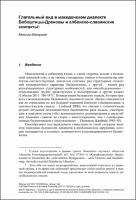Chapter Глагольный вид в македонском диалекте Бобоштицы-Дреновы и албанско-славянские контакты
| dc.contributor.author | Makartsev, Maxim | |
| dc.date.accessioned | 2023-11-27T17:12:50Z | |
| dc.date.available | 2023-11-27T17:12:50Z | |
| dc.date.issued | 2023 | |
| dc.identifier | ONIX_20231127_9791221501841_21 | |
| dc.identifier.issn | 2612-7679 | |
| dc.identifier.uri | https://library.oapen.org/handle/20.500.12657/85611 | |
| dc.language | Russian | |
| dc.relation.ispartofseries | Biblioteca di Studi Slavistici | |
| dc.subject.other | Balkan linguistics | |
| dc.subject.other | language contact | |
| dc.subject.other | Slavic dialects of Albania | |
| dc.subject.other | south-eastern Macedonian dialects | |
| dc.subject.other | verbal aspect | |
| dc.title | Chapter Глагольный вид в македонском диалекте Бобоштицы-Дреновы и албанско-славянские контакты | |
| dc.type | chapter | |
| oapen.abstract.otherlanguage | Verbal aspect in the Macedonian dialect of Boboshtica-Drenova and Albanian-Slavic language contact - Long-term subdominant bilingualism with Albanian has had a significant impact on verbal aspect marking in the Macedonian dialect of Boboshtica-Drenova (South-East Albania). The Slavic formal opposition of perfective and imperfective aspect marked through a variety of derivational methods has been preserved. However, under Albanian influence two continuous aspect constructions have been grammaticalised in the dialect, one of them based on the locative ǵe, and the other on the adversative conjunction toko. The paths of grammaticalization of these markers are investigated, which include structural transfer (ǵe < locative and temporal tek, toko < adversative and continuous po), which is partially supported by the phonetic similarity between the respective Albanian and Macedonian dialectal markers (toko || duke, tek). | |
| oapen.identifier.doi | 10.36253/979-12-215-0184-1.08 | |
| oapen.relation.isPublishedBy | bf65d21a-78e5-4ba2-983a-dbfa90962870 | |
| oapen.relation.isbn | 9791221501841 | |
| oapen.series.number | 53 | |
| oapen.pages | 22 | |
| oapen.place.publication | Florence |

